As winter settles in, the question of how cold is too cold for dogs to venture outside becomes a pertinent concern for pet owners. While some may believe that dogs are inherently equipped to withstand frigid temperatures, the reality is far more nuanced. Factors such as breed, age, size, and overall health can significantly impact a dog's tolerance to cold weather.
But where does one draw the line between a brisk romp in the snow and potentially harmful exposure? This discussion will explore the intricacies of determining the optimal winter conditions for our furry companions, shedding light on the critical considerations that should guide our decisions when it comes to winter outings with our dogs.
Key Takeaways
- Dogs should not be kept outside if the temperature drops below 30 degrees.
- Monitor dogs for signs of cold like shivering, hunched posture, or lifting paws.
- Protect dogs' paws with booties to prevent frostbite and discomfort.
- Breeds, age, and health conditions affect dogs' tolerance to cold weather.
Dog's Cold Sensitivity Factors
Factors influencing a dog's sensitivity to cold weather encompass breed characteristics, coat thickness, age, and overall health status. Certain breeds, like Siberian Huskies, Malamutes, and Saint Bernards, are better equipped to handle colder temperatures due to their genetic makeup. Dogs with thicker double coats or undercoats are more insulated against the cold, whereas those with short or thin coats may need additional protection.
Puppies, senior dogs, and those with health issues have a harder time regulating their body temperature in cold weather. Monitoring these factors is crucial to ensuring your dog's well-being during winter months. By understanding these sensitivity factors, owners can take appropriate measures to keep their furry companions safe and comfortable in chilly conditions.
Importance of Breed and Coat
Breed and coat characteristics significantly impact a dog's ability to withstand cold weather conditions. When considering a dog's ability to handle the cold, factors such as breed origin and coat density play a crucial role.
Here are some key points to consider:
- Breeds from colder climates: Dogs bred in colder regions, such as Huskies or Malamutes, have adaptations that make them more resilient to low temperatures.
- Coat thickness: Dogs with thicker, double-layered coats like Newfoundlands or Bernese Mountain Dogs are better equipped to handle cold weather.
- Short-haired breeds: Breeds with short or thin coats, such as Chihuahuas or Greyhounds, may struggle in colder conditions and require extra protection.
Understanding your dog's breed and coat characteristics is essential for their comfort and safety in winter.
Vulnerable Dog Groups
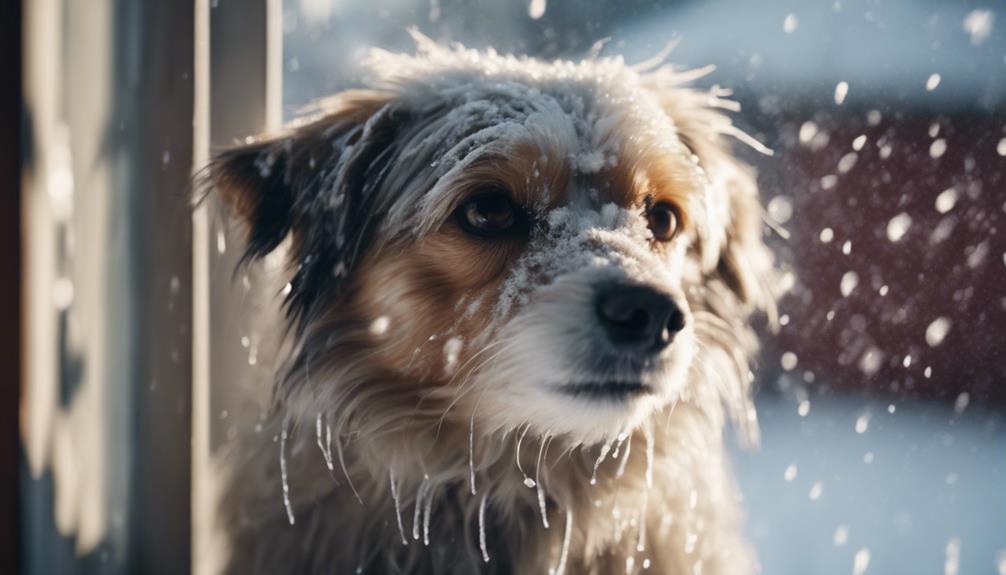
Certain groups of dogs are particularly vulnerable to the cold weather's adverse effects, requiring special attention and care to ensure their well-being. Puppies have underdeveloped systems that struggle to regulate body temperature, making them more susceptible to the cold.
Geriatric dogs may have weakened immune systems and thinner coats, leaving them less able to withstand low temperatures. Dogs with health conditions such as diabetes, heart disease, or arthritis are also at higher risk in cold weather due to their compromised health.
It is crucial for owners of these vulnerable dog groups to take extra precautions, such as limiting outdoor time in frigid temperatures, providing warm shelter, and monitoring closely for any signs of discomfort or distress related to the cold.
Weather Impact on Dogs
In winter, understanding how weather conditions affect dogs is crucial for ensuring their well-being and safety. Weather can have a significant impact on dogs, influencing their comfort and health. Here are some ways in which weather can affect our furry friends:
- Temperature Fluctuations: Dogs can struggle to regulate their body temperature in extreme cold or heat.
- Humidity Levels: High humidity can make it harder for dogs to cool down through panting.
- Wind Chill: Wind chill can make temperatures feel colder than they actually are, affecting dogs' tolerance levels.
Being mindful of these weather factors can help dog owners better protect their pets during the winter months.
Minimum Temperature Threshold
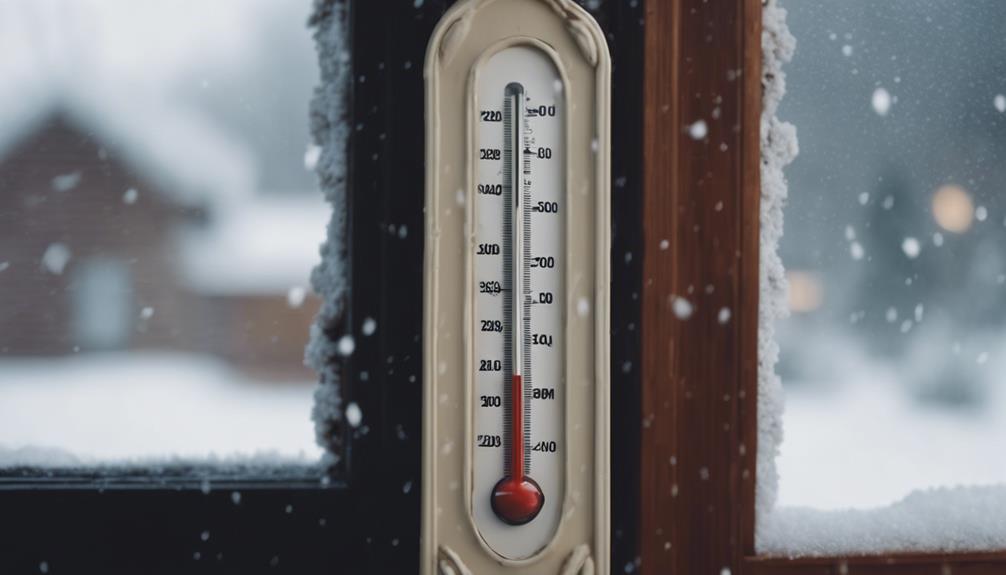
Understanding the critical threshold temperature is essential for safeguarding dogs against the risks of cold weather conditions. While dogs' tolerance to cold varies based on breed, coat thickness, and other factors, a general rule of thumb is that dogs should not be kept outside if the temperature drops below 30 degrees Fahrenheit. Breeds from colder climates or with thicker coats may withstand lower temperatures, but puppies, older dogs, and those with health issues are more sensitive to the cold.
Factors like wind chill and precipitation can make the temperature feel colder than it actually is. Monitoring the temperature and being aware of your dog's individual needs are key to ensuring their safety and well-being during winter outdoor activities.
Signs of Dog Coldness
Recognizing the subtle signs of coldness in dogs is crucial for ensuring their well-being during the winter months. It is important for dog owners to be vigilant and responsive to any indications that their furry companions may be feeling the chill. Some signs that your dog may be feeling cold include:
- Shivering: Dogs shivering is a common sign of feeling cold.
- Hunched Posture: If your dog is hunching their body, they might be trying to conserve heat.
- Lifting Paws: Dogs lifting their paws off the ground could be a sign that they are trying to avoid the cold surface.
Monitoring your dog closely for these signs can help you take appropriate measures to keep them warm and comfortable in the cold weather.
Symptoms of Hypothermia
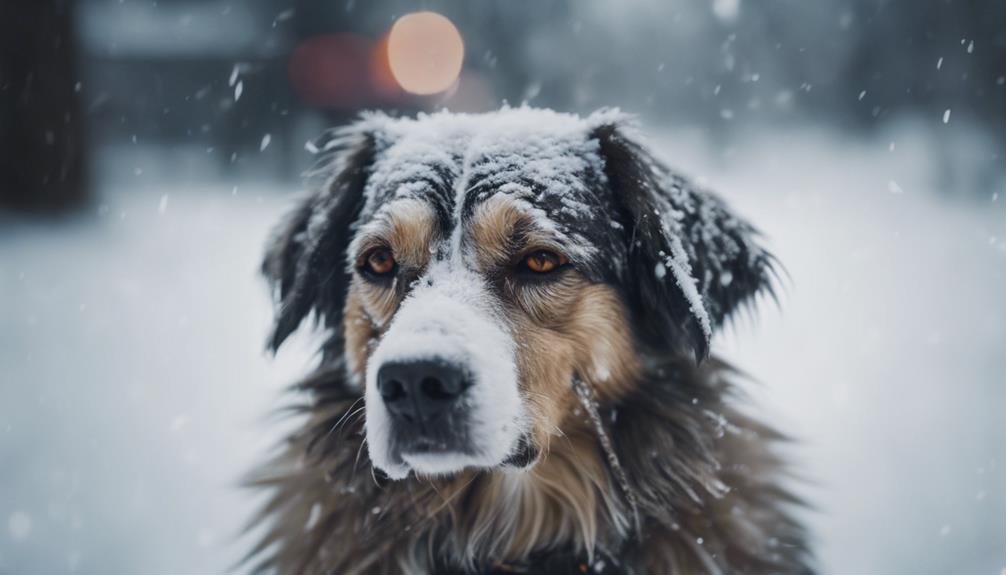
To ensure the well-being of dogs during the winter months, it is crucial to be aware of the symptoms of hypothermia, a serious condition that can arise from prolonged exposure to cold temperatures. Symptoms of hypothermia in dogs include shivering, lethargy, muscle stiffness, shallow breathing, weak pulse, and in severe cases, loss of consciousness.
Dogs with hypothermia may also exhibit signs such as a weak heartbeat, dilated pupils, and a lack of response to stimuli. It is essential to monitor your dog closely for these symptoms, especially when temperatures drop significantly.
Prompt recognition and treatment of hypothermia are vital to prevent further complications and ensure the well-being of your furry companion during the winter season.
Urgent Hypothermia Care
In cases of urgent hypothermia care for dogs, immediate and appropriate actions are crucial to prevent further complications and ensure the animal's well-being. When faced with a dog suffering from hypothermia, follow these steps:
- Move the dog to a warm environment: Transfer the dog to a heated area to prevent further heat loss.
- Wrap the dog in warm blankets: Use dry, warm blankets to cover the dog and help raise their body temperature.
- Seek veterinary assistance: Contact a veterinarian promptly for further evaluation and treatment to ensure the dog's recovery.
Monitoring Dog Behavior
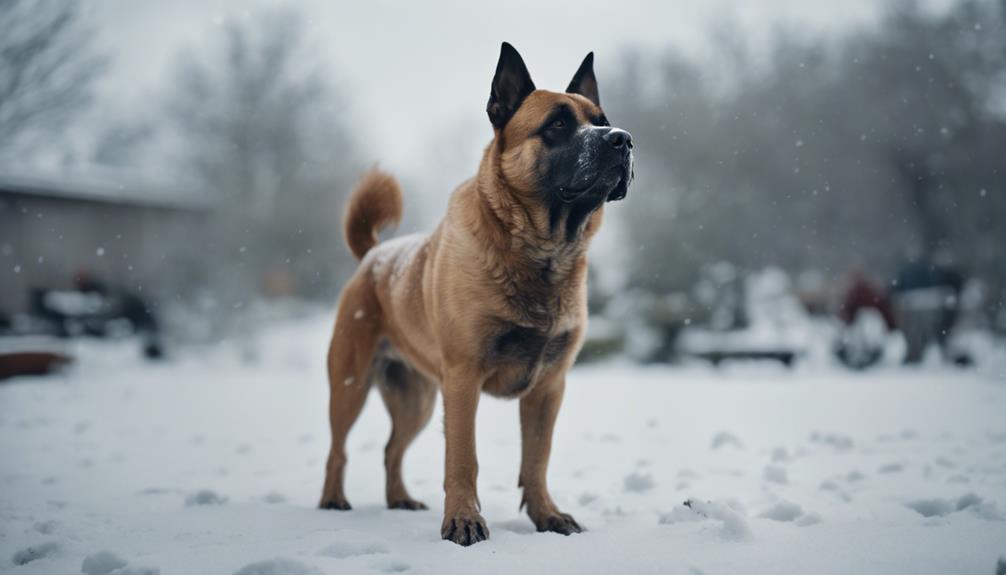
When ensuring the well-being of dogs in cold weather, closely monitoring their behavior is a key indicator of their comfort and health status. By observing your dog's actions, you can assess if they are feeling too cold and take appropriate measures. Here is a table to help you understand what behaviors to look out for:
| Behavior | Possible Sign | Action |
|---|---|---|
| Shivering | Feeling cold | Bring your dog indoors or provide a blanket |
| Lifting paws | Discomfort from cold ground | Consider booties to protect their paws |
| Seeking shelter | Avoiding exposure to the cold | Provide a warm and sheltered environment |
| Excessive lethargy | Potential hypothermia | Contact a vet for immediate attention |
Preparing Dogs for Cold
Ensuring dogs are adequately equipped for cold weather involves diligent preparation and attention to their specific needs. It is crucial to provide them with the necessary protection to keep them safe and comfortable during the winter season.
Consider the following tips to prepare your dog for cold weather:
- Dress your dog in a warm coat or sweater to provide an extra layer of insulation.
- Protect their paws with booties to prevent frostbite and irritation from cold surfaces.
- Ensure they have access to shelter and a cozy bed to escape the cold temperatures.
Risk of Thin-Coated Breeds
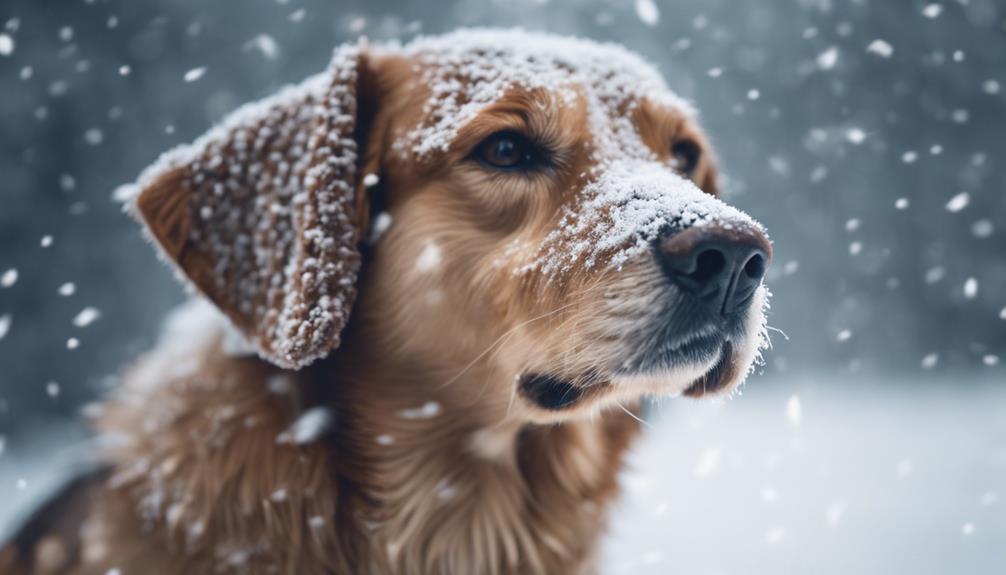
With their minimal fur protection, thin-coated breeds are particularly vulnerable to the cold weather's harsh effects, requiring extra care and attention during winter months. Breeds such as Greyhounds, Whippets, and Chihuahuas have thin coats that offer little insulation against low temperatures. These dogs are more prone to hypothermia and frostbite, especially when exposed to cold, windy conditions.
It is crucial for pet owners of thin-coated breeds to monitor their dogs closely during winter outings, limiting their time outdoors when temperatures drop significantly. Providing these dogs with appropriate clothing, such as sweaters or coats, can help mitigate the risks associated with their thin fur. Additionally, ensuring they have a warm and cozy shelter indoors is essential for their well-being in cold weather.
Car Safety Precautions
Implementing safety measures in vehicles for dogs during winter is crucial to ensure their well-being and comfort while traveling. To safeguard your furry companion during car rides in the cold season, consider the following precautions:
- Secure your dog with a harness or a seat belt designed for pets to prevent injuries during sudden stops or accidents.
- Use a crash-tested dog crate or a pet car seat to provide a safe and cozy space for your dog while traveling.
- Never leave your dog unattended in a cold car to avoid potential risks of hypothermia or frostbite.
Winter Attire for Dogs

When preparing your canine companion for winter, selecting appropriate attire is essential for their warmth and protection. Dogs with short fur or those less tolerant to cold may benefit from wearing coats or sweaters to help maintain their body heat. These garments should fit well, covering the dog's back from neck to tail without restricting movement.
Booties can also be beneficial in protecting their paws from cold surfaces, salt, and ice-melting chemicals that can cause irritation or injury. Additionally, waterproof clothing can help keep dogs dry in snowy or wet conditions, preventing them from getting too cold or uncomfortable.
Proper winter attire for dogs is crucial in ensuring their well-being during the colder months.
Veterinary Consultation Importance
Considering the critical role of proper winter attire in safeguarding dogs from the cold, the importance of seeking veterinary consultation becomes paramount to ensure comprehensive care for their well-being. Veterinary consultation provides tailored advice based on the individual dog's health, breed, age, and specific needs, optimizing their well-being in winter conditions. Moreover, early detection of potential health issues related to cold weather can prevent more severe complications.
- Veterinarians can recommend specialized winter diets to support dogs' energy requirements in colder temperatures.
- Regular veterinary check-ups can help monitor any adverse effects of winter conditions on dogs' health.
- Veterinarians can provide guidance on adjusting exercise routines to keep dogs active and healthy during the winter months.
Conclusion
In conclusion, understanding the factors that influence a dog's tolerance to cold weather is essential in ensuring their well-being during the winter months. Factors such as breed, coat thickness, and overall health play a significant role in determining the minimum temperature threshold at which dogs can safely be outdoors.
By taking proactive measures such as providing appropriate winter attire and seeking veterinary consultation when needed, pet owners can effectively protect their canine companions from the adverse effects of cold weather.




